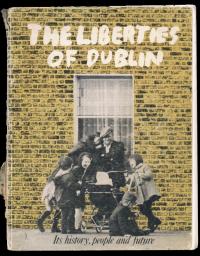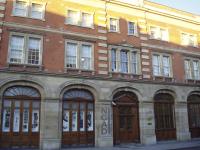Taking Liberties: what happened?
Published in
20th-century / Contemporary History,
Features,
General,
Issue 1(Jan/Feb 2013),
Volume 21
 I’m looking at my beaten-up copy of The Liberties of Dublin when Eddie Kelly’s photo from the book launchparty drops out. It’s stamped ‘Irish Times, June 16th, 1973’. We’re sitting on the steps of Marsh’s Library, with curator Muriel McCarthy beaming just off camera. It’s another Ireland and I’m young and foolish in the long skirt of the day—yards of Basement Boutique scarlet, smirking as Éamon MacThomáis of An Phoblacht (to my right) and Breandán Ó Ríordáin of the National Museum (to my left) squint at my copy.
I’m looking at my beaten-up copy of The Liberties of Dublin when Eddie Kelly’s photo from the book launchparty drops out. It’s stamped ‘Irish Times, June 16th, 1973’. We’re sitting on the steps of Marsh’s Library, with curator Muriel McCarthy beaming just off camera. It’s another Ireland and I’m young and foolish in the long skirt of the day—yards of Basement Boutique scarlet, smirking as Éamon MacThomáis of An Phoblacht (to my right) and Breandán Ó Ríordáin of the National Museum (to my left) squint at my copy.
Who knew we could make a book? We didn’t. There’s a jokiness about the escapade, it’s a caper movie. A diverse-looking bunch, we all wear the high spirits of astonishment (although maybe we were drunk). Anyway, if you like Marx Brothers movies, you’ll know why I felt like Margaret Dumont in Duck Soup, with Éamon as Chico and soon to go to Mountjoy Jail.
Meeting Larry Dillon
What amazes me most about this gathering is the accident of meeting prominent Liberties activist Larry Dillon. Larry had invited Jeremy Williams to the Clock Bar, Thomas Street, to discuss saving the Marshalsea, a huge 1740s debtors’ barracks where ‘improvident men of the Ascendancy could take refuge from their creditors with their wives and children—or from them!’, said Mary Murtagh, adding casually that it was one of Robert Emmet’s arsenals, and had a secret tunnel too.
Still a student, I was waitressing and guiding in Castletown House and editing TCD Miscellany. Architectural historian Maurice Craig arrived there one day with UCD students, including Jeremy Williams. They’d created a conservation coalition called RAGE (Radical Action for Good Environment), aiming to fight demolition orders. Maurice was hugely inspirational. His book Dublin 1660–1860 was not just beautifully written but also a readable blueprint for activists who wanted continuity of community. His leonine head, walrus-like hrmmphing over grammatical errors, generosity with time, social fluidity and ancient sweater knitted from dog hair were all familiar to RAGE, as were his actress partner Agnes Bernelle and their kids later, too.
Penniless architecture students seeking cheap digs and interested in repurposing old buildings, RAGE wanted to turn the Marshalsea into affordable student housing. They calculated that it would be paid off if a hundred students paid two pounds rent weekly. Bill Hastings gave us his photo of it for TCD Miscellany and I churned out a piece for the Irish Times. Cheap digs away from home; thick, soundproof walls! Where was this heavenly spot? Only ten minutes on foot from College Green? Take us there! Jeremy went to look at it and found a lone pensioner living inside its unheated stone walls. He’d been evicted from his Finglas council place for owning a pet goat. He couldn’t bring it here so now he’d found a stray cat.
We met Larry Dillon at the Clock Bar and Larry began telling us the history of the Liberties. It was another country, ‘heart of the rowl’, still at odds with the Corpo and so riddled with CPOs [compulsory purchase orders] that it now resembled ‘a mouth of broken teeth’. ‘I’ll talk to the divil himself if he helps us, and I’m not afraid to say so!’, he said. For the full vigour of Larry in spate you’ll have to read his chapter in the book:
‘We are still talking while this insane planning leaves out the heart of any great city, its people. I issue a challenge to look at the derelict sites, car parks, piggeries, scrap yards . . . Yes, the pigs and the scrap yards are taking over and the people are moved out . . .’
That was Larry, ahead of his time.
Of course we swore to save the Marshalsea, and Larry introduced us to Mrs Kitty Ryan’s of Meath Street, where Jeremy sang Leonard Cohen’s Suzanne. After listening in respectful silence to ‘For you’ve touched her perfect body with your mind’, the regulars clapped. Then (in case it was me up next with Hallelujah, maybe), Larry struck up ‘Alone, all alone . . .’ and we sang The Valley of Slievenamon. I wanted to sing it nightly, and more or less did. Ryan’s stood us the first of many, many, many pints, and I moved in for decades.
Soon after, I went back to see the lonely pensioner again. He was crying because some boys from the adjacent Oliver Bond flats had killed his cat. He’d found the cat hanging from the only toilet. ‘Ah, holy God, isn’t that horrible, and if I ever get my bleeding hands on them I’ll bleeding well mangle them!’ said Larry.
Marshalsea demolished

Irish Distillers became the National College of Art and Design. (DubhEire)
But when I came back from a J1 stint working in New York diners, there was a hole at the end of Marrowbone Lane. The Marshalsea was demolished, with no pensioner (had they hung him from a toilet too?). I was speechless with fury. But Jeremy had found a little house behind St Catherine’s, and I had found ‘the cause’. I went to live in the house—Jeremy preferred his landlady’s cooking—with Trinity classmates James Morris, Russ Russell and Dan Shine (now Head of Medicine at NYU’s teaching hospital). Larry warned us that it was next to a slaughterhouse. Reporter Lionel Fleming lent me a mattress, and I became a Libertine.
Larry was right; an occasional piglet would throw itself upon our mercy, but nightingales still sang in St Catherine’s graveyard. We were the bane of our neighbours, the Greens. Una Green now lives near me in San Francisco and remembers me knocking on the door during a rowdy party to hand her father, Tom, a pair of earplugs. Incensed by the sight of one woman journalist kissing another on the bonnet of his car, he roared ‘And you know where you can stick these!’ and threw them back.
First Liberties Festival
Soon a regular at Ryan’s, I was recruited onto the first Liberties Festival. Headlined by the Chieftains at St Catherine’s, it was run by my long-suffering friend Maura Ryan of ‘the shop’ and included a Christ Church exhibit of Michael O’Brien’s drawings of Liberties landmarks like the Brazen Head. We asked Pat Healy, Mary Murtagh and Peter Walsh to flesh out the festival programme with local lore, and it was clear that we had a book. But who would publish it? By then I was living over the Old Stand pub. Since it was impossible to find anyone to pay us to publish it, how about private subscriptions of, er, £50?
Michael’s father, respected printer Tom O’Brien, said that he could print it first and worry about money later. Michael and Valerie knuckled down to cowgum and scalpels while I found old photos in the National Library and taped oral histories from Iveagh Market traders. Lo and behold us on the steps of Marsh’s Library, with the Evening Press splashing a pin-up of Sister Ann Dominica and headlining it ‘How I Fell In Love With A Nun’, by Terry O’Neill.
Years of festivals, plans, meetings, excavations and many, many renditions of Slievenamon at Mrs Kitty Ryan’s followed. Larry moved to Gray Square and died in the 1990s, RIP. It’s generally agreed that he saved the Liberties, but it was a sad decade. In the ’80s, vandals burned out ‘the last of the weavers’, Padraig Breathnach, and his looms twice, and attacked him too, as drug traders encroached on businesses, terrorising pubs and people. ‘If I ever get my bleedin’ hands on them . . .’, Larry fumed. But he was fast failing of liver disease and Ryan’s was considering selling up. Weaver’s Square had gone the way of South Brown Street, but you could still make out shapes and shadows of Dutch billies around Weaver’s Square and Fumbally Lane. Padraig Breathnach st
 I’m looking at my beaten-up copy of The Liberties of Dublin when Eddie Kelly’s photo from the book launchparty drops out. It’s stamped ‘Irish Times, June 16th, 1973’. We’re sitting on the steps of Marsh’s Library, with curator Muriel McCarthy beaming just off camera. It’s another Ireland and I’m young and foolish in the long skirt of the day—yards of Basement Boutique scarlet, smirking as Éamon MacThomáis of An Phoblacht (to my right) and Breandán Ó Ríordáin of the National Museum (to my left) squint at my copy.
I’m looking at my beaten-up copy of The Liberties of Dublin when Eddie Kelly’s photo from the book launchparty drops out. It’s stamped ‘Irish Times, June 16th, 1973’. We’re sitting on the steps of Marsh’s Library, with curator Muriel McCarthy beaming just off camera. It’s another Ireland and I’m young and foolish in the long skirt of the day—yards of Basement Boutique scarlet, smirking as Éamon MacThomáis of An Phoblacht (to my right) and Breandán Ó Ríordáin of the National Museum (to my left) squint at my copy.
















